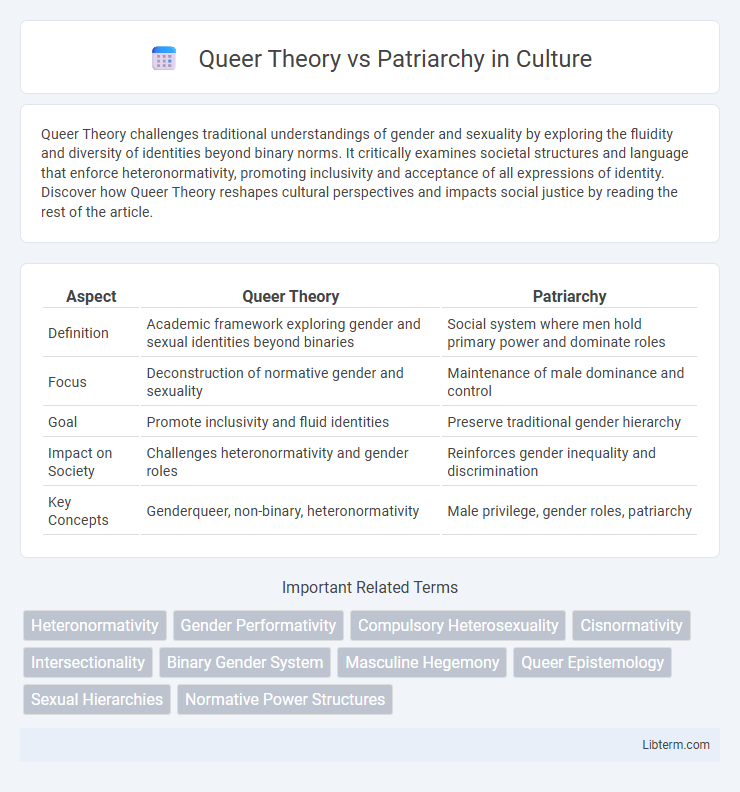Queer Theory challenges traditional understandings of gender and sexuality by exploring the fluidity and diversity of identities beyond binary norms. It critically examines societal structures and language that enforce heteronormativity, promoting inclusivity and acceptance of all expressions of identity. Discover how Queer Theory reshapes cultural perspectives and impacts social justice by reading the rest of the article.
Table of Comparison
| Aspect | Queer Theory | Patriarchy |
|---|---|---|
| Definition | Academic framework exploring gender and sexual identities beyond binaries | Social system where men hold primary power and dominate roles |
| Focus | Deconstruction of normative gender and sexuality | Maintenance of male dominance and control |
| Goal | Promote inclusivity and fluid identities | Preserve traditional gender hierarchy |
| Impact on Society | Challenges heteronormativity and gender roles | Reinforces gender inequality and discrimination |
| Key Concepts | Genderqueer, non-binary, heteronormativity | Male privilege, gender roles, patriarchy |
Understanding Queer Theory: Key Concepts
Queer Theory challenges traditional norms by deconstructing fixed categories of gender and sexuality, emphasizing fluidity and the social construction of identities. It critiques patriarchy as a system enforcing heteronormative dominance and marginalizing non-normative experiences. Central concepts include heteronormativity, performativity, and intersectionality, which reveal how power structures shape and constrain individual identities.
Defining Patriarchy: Structures and Impacts
Patriarchy constitutes a socio-political system where men hold primary power in roles of political leadership, moral authority, social privilege, and control over property. It establishes hierarchical structures that marginalize women and queer identities, reinforcing gender norms and limiting social mobility. The pervasive impact of patriarchy manifests in systemic inequalities, institutionalized sexism, and cultural practices that sustain male dominance across societies.
Historical Roots of Queer Theory
Queer Theory emerged in the early 1990s as an academic framework challenging heteronormative structures and traditional gender binaries entrenched by patriarchal societies. Rooted in post-structuralist thought, it draws heavily from the works of Michel Foucault, who analyzed the social construction of sexuality and power dynamics within patriarchal institutions. This theory critiques the historical dominance of patriarchy by destabilizing fixed identities and advocating for the recognition of diverse sexualities and gender expressions.
Patriarchy’s Influence on Gender and Sexuality
Patriarchy shapes gender and sexuality by enforcing rigid, hierarchical norms privileging male dominance and heterosexuality. This system institutionalizes power imbalances, limiting diverse expressions of identity and reinforcing traditional gender roles. As a result, individuals who deviate from patriarchal expectations often face social marginalization and discrimination.
Queer Theory’s Critique of Patriarchal Norms
Queer Theory critically challenges patriarchal norms by deconstructing traditional gender binaries and exposing how these rigid frameworks enforce heteronormativity and marginalize non-conforming identities. It interrogates power structures embedded in patriarchal systems that perpetuate inequality, discrimination, and exclusion of LGBTQ+ individuals. By destabilizing normative assumptions about gender and sexuality, Queer Theory advocates for fluidity, inclusivity, and social justice.
Intersectionality: Where Queer Theory and Patriarchy Meet
Queer Theory challenges the patriarchal structures by deconstructing rigid gender binaries and highlighting the fluidity of identities, revealing how patriarchy enforces heteronormativity and gender conformity. Intersectionality within Queer Theory examines how race, class, sexuality, and gender converge to compound oppression under patriarchal systems, emphasizing the multidimensional experiences of marginalized groups. This approach exposes the systemic nature of power imbalances, urging transformative social justice that addresses overlapping inequalities embedded in patriarchal cultures.
Queer Resistance to Patriarchal Systems
Queer resistance challenges patriarchal systems by deconstructing traditional gender binaries and rejecting heteronormative norms, empowering marginalized identities. Queer theory highlights how patriarchal power reinforces exclusion and discrimination against LGBTQ+ communities, advocating for fluidity and inclusivity. Activism rooted in queer resistance fosters social justice by promoting equality and dismantling oppressive structures inherent in patriarchy.
Representation and Identity in Queer vs Patriarchal Narratives
Queer Theory challenges patriarchal narratives by deconstructing fixed identity categories and emphasizing fluid, non-normative representations of gender and sexuality. Patriarchal frameworks often enforce rigid, binary identities that uphold male dominance and marginalize diverse expressions of identity. In contrast, Queer Theory promotes inclusive representation that validates marginalized voices and disrupts traditional power structures embedded in patriarchal discourse.
The Role of Power Dynamics in Queer Theory and Patriarchy
Power dynamics in Queer Theory challenge the patriarchal structures that enforce rigid gender norms and heteronormativity, exposing how these norms marginalize LGBTQ+ identities. Patriarchy sustains control through hierarchical dominance, privileging cisgender, heterosexual men while subjugating queer individuals and non-conforming identities. Queer Theory deconstructs these power imbalances by interrogating the social, cultural, and political mechanisms that maintain gender binaries and heterosexist authority.
Moving Forward: Challenging Patriarchy through Queer Perspectives
Queer theory deconstructs traditional gender norms and exposes the limitations of patriarchal structures by highlighting fluid identities and diverse experiences. It challenges the binary frameworks that patriarchy enforces, promoting inclusivity and social justice through intersectional analysis. Moving forward, queer perspectives inspire transformative activism and policy reforms aimed at dismantling systemic oppression and fostering equality across all gender and sexual identities.
Queer Theory Infographic

 libterm.com
libterm.com